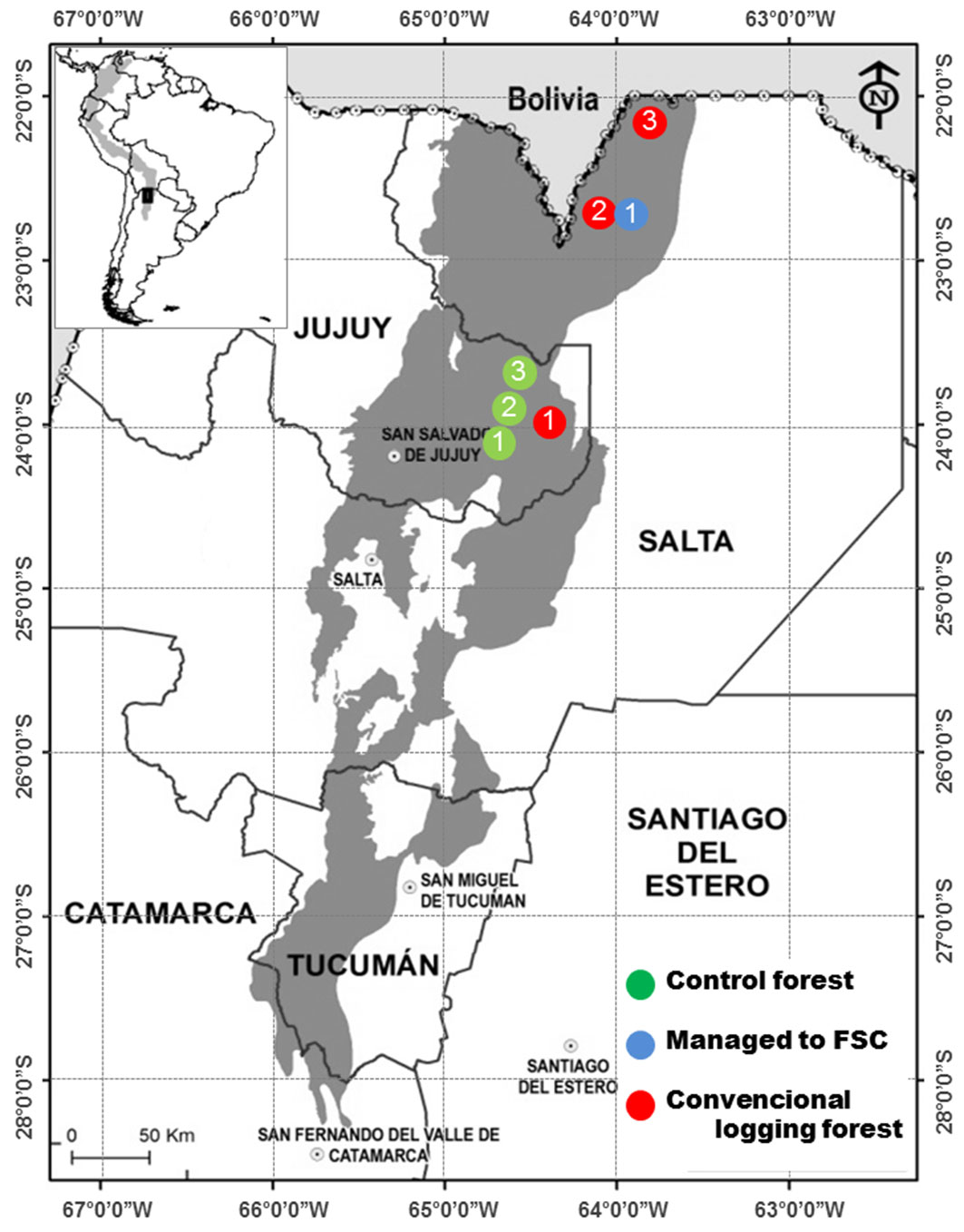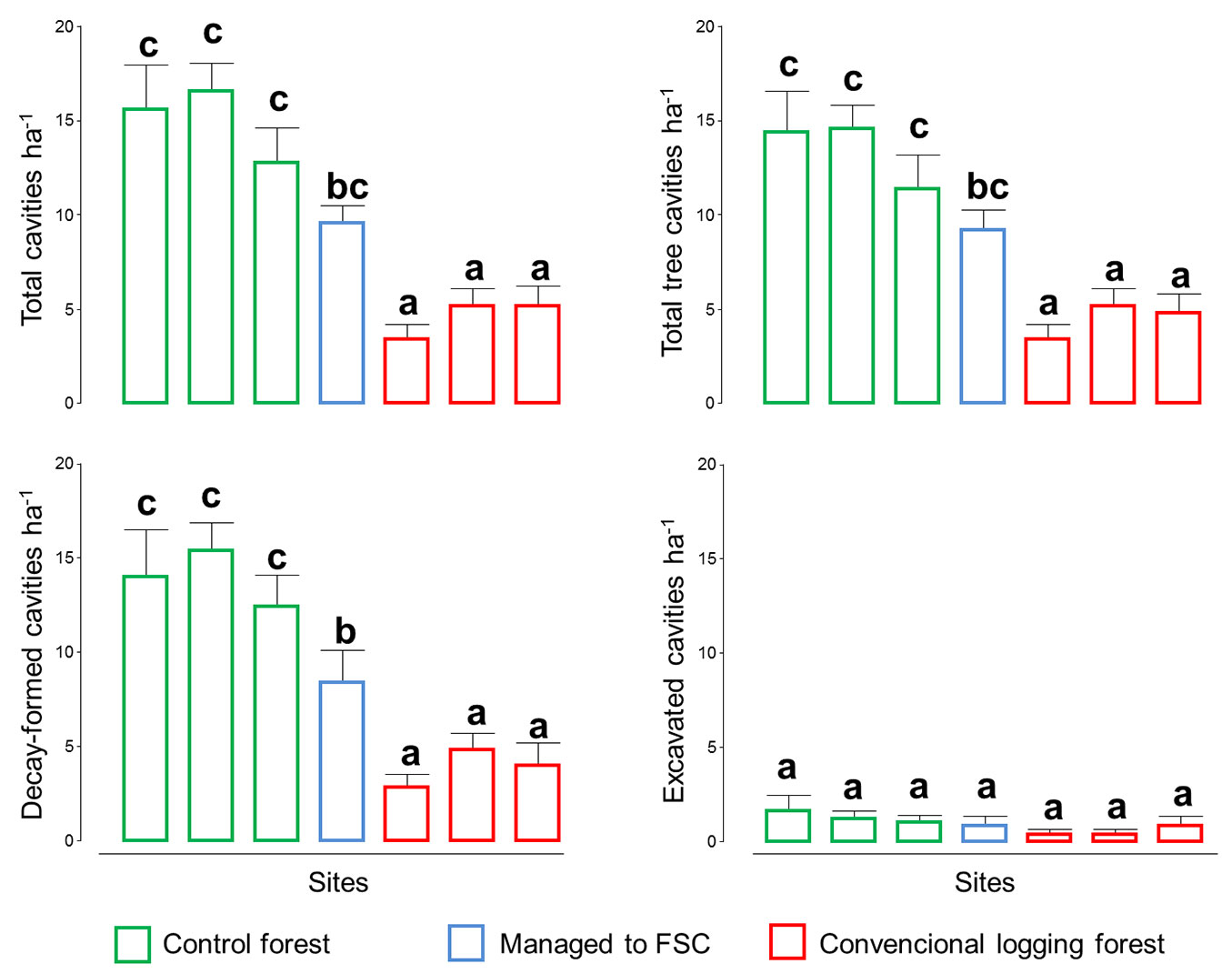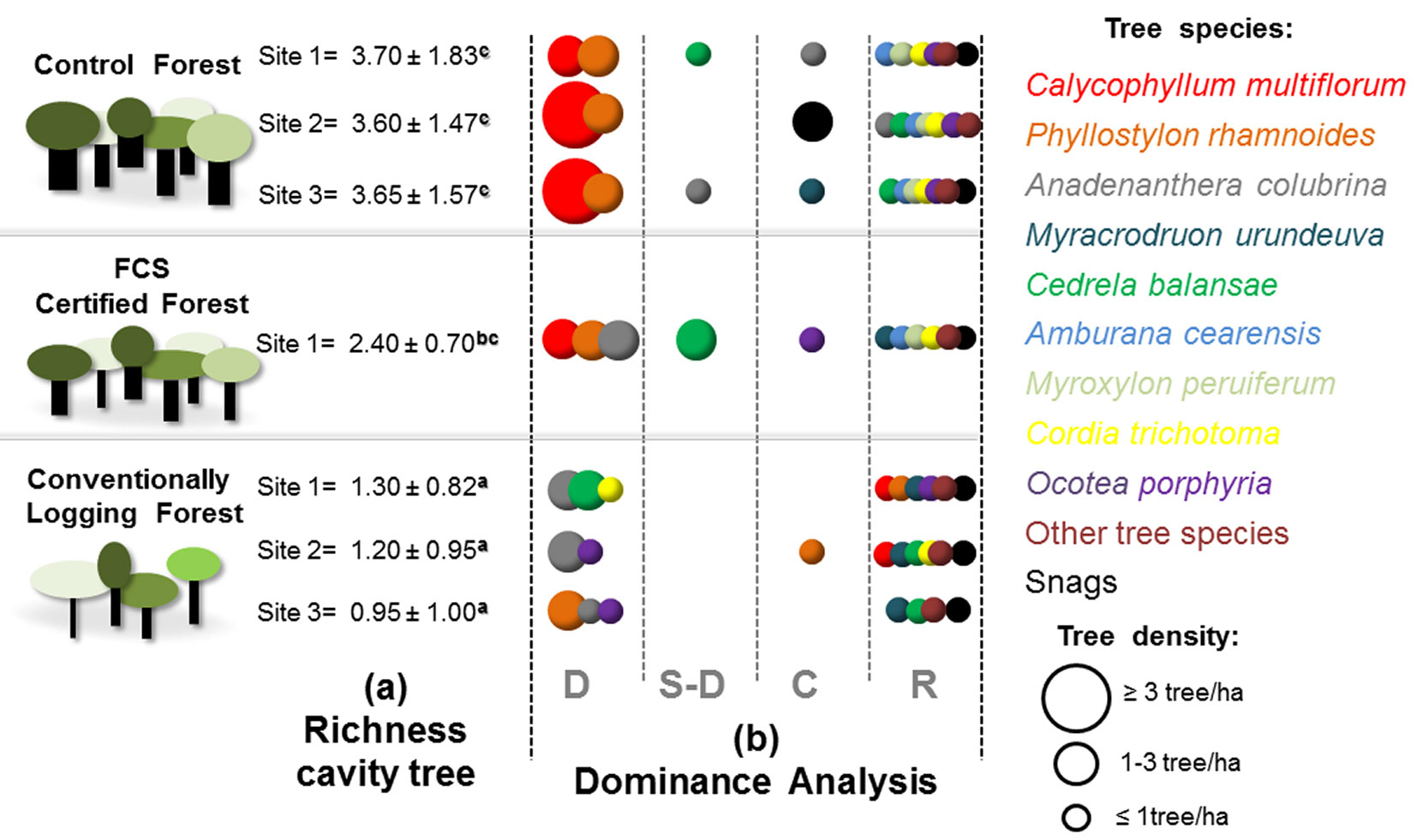
An assessment of the availability of cavities for secondary cavity-nesting birds in certified and conventionally-logged Neotropical rainforests
iForest - Biogeosciences and Forestry, Volume 13, Issue 4, Pages 318-322 (2020)
doi: https://doi.org/10.3832/ifor3220-013
Published: Jul 28, 2020 - Copyright © 2020 SISEF
Short Communications
Abstract
The high level of forest intervention and the decrease in biodiversity as a result of logging are incentives to implement forest certification schemes. Despite the advances in the results of the impact of forest certification on biodiversity, there are few studies on species with specific habits, such as cavity-nesting birds. The objective of this study is to compare the impact of forest certification and conventional logging on the richness, availability (density) and dominance of potentially suitable cavity trees for secondary cavity-nesting birds in the subtropical forests of northwestern Argentina. Seven sites were selected: three control sites which were not logged for at least 40 years, one site under Forest Stewardship Council (FSC) certification, and three sites with conventional logging. The results suggest that logged forests under FSC-certification may guarantee a diversity, availability (density) and dominance of potentially suitable cavity trees for secondary cavity-nesting birds, as well as certain characteristics (such as DBH > 40 cm), similar to unlogged forests for this group of birds. Therefore, we suggest that the forests of northwestern Argentina should be managed by a scheme under forest certification so that the high levels of cavity tree species are maintained.
Keywords
Argentina, Birds, Cavity Trees, Certification Forest, Forest Stewardship Council, South-America, Subtropical Forests
Introduction
Forest degradation and decrease of the associated biodiversity, as a result of unsustainable and unplanned logging (hereinafter referred to as conventional logging) for the world market, were motivations for starting new forest management plans, based on certification standards, in the early nineties, and specially, for tropical and subtropical forests ([28], [7], [15], [3]). Currently, around 3.2% of the world’s forests (more than 100 million ha) were certified and America, in particular, has around 12% of its forests certified ([11]).
Despite some difficulties, forest certifications were very successful in raising awareness and spreading knowledge about the social, economic, and environmental importance of forests ([28], [14]). With regards to the environment, it was shown that certifications (e.g., FSC, Forest Stewardship Council; PEFC, Programme for the Endorsement of Forest Certification) can be effective tools for the conservation of forest biodiversity, based on measures such as reduced logging, retention of key tree species, protection of threatened species and reforestation ([29], [23], [11], [19]). Particularly, the FSC is one of the most well-known certifications worldwide and focuses on the output of forest products, taking into account the economic, social, and environmental components ([16]). Specifically, the environmental component of the FSC certification promotes environmentally responsible logging, selective logging with reduced impact logging (e.g., high-value tree species), waste reduction and hunting restrictions ([22], [12], [16], [21]). However, many of these results come from temperate forests and little is known about the potential importance and effectiveness of certification in tropical and subtropical forests ([28], [6]). Furthermore, in many cases, the assessment and monitoring of forest biodiversity do not consider guidelines for animal species with specific life-history traits ([17], [19], [1]), such as cavity-nesting birds.
Cavity-nesting birds require trees with specific characteristics (e.g., species, size, trees available) and these tree species are generally the most logged by forestry companies ([20], [9], [26], [31], [32]). Relatively few studies assessed the impact of forest management certification on the availability of cavities for secondary cavity-nesting birds ([35]). Thus, the objective of this study is to compare the impact of forest management under certification with unlogged forest sites and conventional logging on cavity availability for secondary cavity-nesting birds, in a subtropical forest of northwestern Argentina. Richness, availability (density), dominance and characteristics (such as DBH, cavity entrance area) of cavity tree species in unlogged, certified and conventionally logged forests are also analysed. We expect that certified sites have less availability of cavities than unlogged sites but higher than sites with conventional logging. In addition, we expect that sites under certification have a diversity of cavity trees similar to that of unlogged sites, since tree species are conserved due to the reduction of environmental impacts (reduced impact logging).
Methodology
Study area
This study was conducted in the subtropical piedmont forests of northwestern Argentina and they are part of the seasonal dry forests of South America ([27]). The climate in this area is highly seasonal, with a rainfall between 800 and 1000 mm, concentrated in the austral summer (November to February). These forests are located at altitudes ranging between 400 and 900 m a.s.l. ([2]). The dominant tree species are Calycophyllum multiflorum, Phyllostylon rhamnoides, Anadenanthera colubrina, Myroxylon peruiferum and Myracrodruon urundeuva ([4], [5]).
Fieldwork and data analyses
Field sampling was conducted from 2014 to 2016 at seven sites located in Salta and Jujuy provinces: three sites without logging activity for at least 45 years (control sites), one site under FSC certification and three sites with conventional logging (Fig. 1). Nowadays, FSC regulations for sustainable forest management include protection of the ecosystem (e.g., bodies of water, riparian zones), environmental impact assessment and protection of endangered species and their habitats. In our study site, FSC certification implied very rigorous actions, such as the retention of some tree species with highly-valued timber to guarantee the regeneration of these tree species within the forest, the use of reduced impact logging, and the protection of threatened tree species (data provided by site owners).
Fig. 1 - Sites in the piedmont forests of northwestern Argentina where field sampling was conducted from 2014 to 2016.
At each site, an area of 100 ha was marked for sampling. Within these areas, 10 to 20 plots of 0.25 ha were defined (see Tab. S1 in Supplementary material). In each plot, cavities with an entrance of >5 cm diameter and up to 16.8 m height were inspected using a mini-camera system attached to an extendable pole ([30]). Cavity trees were identified to species level, but standing dead trees were grouped into the single category, called “snags”. Cavity tree richness was determined as the mean number of tree species with at least one cavity which can be potentially used, per plot. It was estimated taking into account our knowledge of the potential use of cavities suitable for secondary cavity-nesting birds. We considered a cavity to be potentially suitable if it had a hollow chamber surrounded by sound wood, accessed by a cavity entrance with a floor to support an incubation chamber, and a roof to provide overhead protection (classification based on prior knowledge of the cavities used by the species of birds - [25], [26]). Similarly, we also calculated the cavities and the total cavity trees per plot (Density ha-1). The density (availability) of each cavity tree species was calculated per site and then classified into: < 1 cavity tree ha-1, 1-3 cavity trees ha-1 and > 3 cavity trees ha-1 ([32]). In addition, the following variables were measured for cavity trees registered in each plot: cavity type (cavities resulting from decay-formed or excavated by woodpeckers), DBH (diameter at breast height), cavity and tree height; cavity location (i.e., main trunk, primary branch, secondary branch, and tertiary branch), cavity entrance area (by measuring the horizontal and vertical diameters of the entrance, and estimated using the formula of an ellipse); and cavity internal depth ([25], [26], [31], [32]). The differences among measured variables were compared between the sites with Kruskal-Wallis tests (H), and using the InfoStat software ([13]).
Finally, we evaluated the dominance of cavity tree species in each site, according to their proportional presence (w) and proportional abundance (Ap) per plot of cavity tree species: (w) is the proportion of sites where a given tree species was present and (Ap) is the proportion of individuals recorded for each species per site. From this analysis, cavity tree species were categorized in four groups: Dominant, Sub-dominant, Common, and rare species (see details in [24]).
Results
In control sites, a total of 23 cavity tree species were registered in the three sites, whereas 20 cavity tree species were registered in the FSC certified site, and 17 cavity tree species in sites with conventional logging (Site1= 15, Site2= 15, and Site3= 14 cavity tree species - Fig. S1 in Supplementary material). Cavity density (H= 52.21, P<0.001), and cavity tree density (H= 46.71, P<0.001) were significantly higher in control and certified sites than in conventionally logged sites. Decay-formed cavity density (H= 47.78, P<0.001) was significantly higher in control sites than in certified and conventionally logged sites. There were not significant differences in density of excavated cavities between sites (H= 2.32, P=0.567) (Fig. 2, Tab. S1). The DBH, and internal cavity depth did not show significant differences between control and FSC certified sites, but they were significantly higher than in conventionally logged sites (H= 30.32, P< 0.001 - Fig. 3). Cavity height did not show significant differences between sites (H= 9.97, P=0.125) (Fig. 3, Tab. S1).
Fig. 2 - Density (mean ± SE) of the total cavities and total trees with cavities at the seven sites with different levels of logging in the piedmont forests of northwestern Argentina. The different letters show significant differences between sites (Kruskal-Wallis test, with a P<0.05). Numeric values shown in Tab. S1 (Supplementary material).
Fig. 3 - Comparison between the characteristics of trees with cavities at seven sites with different levels of logging in the piedmont forests of northwestern Argentina. Different letters show significant differences between sites (Kruskal-Wallis test, with a P<0.05). Numeric values shown in Tab. S1 (Supplementary material).
Cavity tree species richness per plot was significantly higher in control and certified sites than in conventionally logged sites (H = 53.43, P<0.0001 - Fig. 4a). The cavity tree species with the highest density in control and FCS certified sites were C. multiflorum (1-3 and >3 tree ha-1) and P. rhamnoides (1-3 and >3 tree ha-1). In conventionally logged sites, we recorded different densities of cavity tree species (Fig. 4b). In all sites, there was a relatively large proportion of rare cavity tree species, whereas few of these species were Dominant, sub-Dominant and Common. It should be noted that snags are Common species in one control site (Fig. 4b, Fig. S1).
Fig. 4 - (a) Richness analysis of tree species with cavities in the piedmont forests of northwestern Argentina. Different letters indicate mean differences between sites (Kruskal-Wallis test, P<0.05). (b) Dominance analysis performed for each site. D= dominant, S-D= subdominant, C= common, U= rare. The different tree species with cavities and their densities are shown in detail. Tree species were grouped into “Other tree species” (see Fig. S1 in supplementary material)
Discussion
The results of our study suggest that management under certification might guarantee richness, availability (density) and certain characteristics (such as DBH) of tree cavities similar to the control forests for secondary cavity-nesting birds. This may show that in these subtropical forests FSC-certified sites can maintain tree levels and characteristics suitable for secondary cavity-nesting birds. This fact is important, since many bird species of this group depend on large trees ([32]), which are reduced or absent in sites without forest certification. The low density of cavity tree species, as well as the changes in their characteristics, at sites under conventional logging, might be due to the selective logging of tree species without management plans which include sustainability criteria ([26]). Other studies in Neotropical rainforests showed that conventional logging can significantly reduce the availability of cavity trees ([8], [10], [25], [26]).
The results of dominance of cavity tree species were similar in control and certified sites, with the exception of A. colubrina, which is present as a dominant cavity tree species at certified sites. This particular tree species is a pioneer in sites under forest exploitation in piedmont forests ([26], [33]) and this may be the reason why it is dominant in sites under this type of certification, as well as in sites of conventionally logged forests. The absence of certain cavity tree species (such as A. cearensis and M. peruiferum), as well as the decrease in their abundance in conventionally logged sites, may be due to the way in which logging was carried out ([26], [33]). Structural characteristics and dominance of tree species varied significantly and such differences between the forest logging types may reflect factors associated with tree species ([24]), such as the DBH or cavity entrance area. Therefore, management strategies for subtropical forest should aim at maintaining a heterogeneous mix of tree species which provide habitat requirements for cavity-nesting birds ([26], [32]).
In addition, a similar richness of cavity tree species was recorded at certified and control sites, including high-value timber species such as C. multiflorum, C. balansae, M. urundeuva, A. cearensis (currently classified as Endangered species by the IUCN), M. peruiferum, and Schinopsis lorentzii. These species were absent (e.g., A. cearensis, M. peruiferum and S. lorentzii) or with a lower density (C. multiflorum, C. balansae, M. urundeuva) in conventionally logged sites and this indicates that conventional management of the piedmont forests does not guarantee the presence of all cavity tree species. These tree species are extremely important for secondary cavity-nesting birds ([31]), and A. cearensis, M. peruiferum, and S. lorentzii are particularly used by large secondary cavity-nesting birds ([32]). These large birds, such as toucans, owls, vultures and other insectivorous birds play an important role in seed dispersal and pest control. Therefore, they play an important role in the persistence of the ecosystem services in the forest ([31]).
Conclusion
Despite the fact that more sites with forest certification are needed to fully understand richness, availability (density) and density of cavity trees, this study defines some key characteristics to assure the conservation of avian cavity-nesters. The cavity-nesting bird species inhabiting piedmont forests rely not only on certain tree species in particular but also on their characteristics ([25], [31], [32]). Sites with certified logging keep these specific characteristics (possibly due to reduced impact logging), such as tree size suitable for birds (e.g., DBH > 40 cm). We can affirm that the certification standards implemented in piedmont forests may guarantee the richness and characteristics of key tree species for secondary cavity-nesting birds. This type of management preserves the tree species most used by secondary cavity-nesting birds: C. multiflorum, C. balansae, A. cearensis, M. urundeuva and snags ([31], [32]). These kinds of studies could be used to evaluate the impact of forest certification on specific animal groups, such as those evaluated in the present study ([17], [28]), since the simple implementation of certification standards ensures biodiversity conservation. We suggest continuing with forests under certification (such as FSC) in order to conserve the high levels of biodiversity ([6]), taking into account that tropical and subtropical forests around the world have high biodiversity and provide vital ecosystem services, which are being degraded by unregulated logging activities ([18], [34], [1]).
Acknowledgements
We wish to thank field assistants that contributed with field work. This study was funded by Agencia Nacional de Promoción Científica y Tecnológica (PICT 2012-0892, Préstamo BID), CONICET (PIP 112-201201-00259 CO), CIT-JUJUY (PIO 1402014100133), Rufford small grant, Optic for the tropic, Bergstrom Award, and Idea Wild. AAS is a post-doctoral fellow at CONICET, ET and CGV are doctoral fellows at CONICET, and RAR, NP and LR are researchers at CONICET.
References
Gscholar
Gscholar
Gscholar
Gscholar
Gscholar
Online | Gscholar
Gscholar
Gscholar
Gscholar
Gscholar
Gscholar
Gscholar
Authors’ Info
Authors’ Affiliation
Ever Tallei 0000-0002-5531-6753
Román A Ruggera 0000-0001-7870-4567
Constanza G Vivanco
Luis Rivera
Natalia Politi
Instituto de Ecorregiones Andinas (INECOA), Universidad Nacional de Jujuy - Consejo Nacional de Investigaciones Científicas y Técnicas (CONICET), Av. Bolivia 1239, 4600 San Salvador de Jujuy, Jujuy (Argentina)
Román A Ruggera 0000-0001-7870-4567
Constanza G Vivanco
Luis Rivera
Natalia Politi
Fundación CEBio, Roca 44, 4600 San Salvador de Jujuy, Jujuy (Argentina)
Corresponding author
Paper Info
Citation
Schaaf AA, Tallei E, Ruggera RA, Vivanco CG, Rivera L, Politi N (2020). An assessment of the availability of cavities for secondary cavity-nesting birds in certified and conventionally-logged Neotropical rainforests. iForest 13: 318-322. - doi: 10.3832/ifor3220-013
Academic Editor
Anna Loy
Paper history
Received: Aug 26, 2019
Accepted: May 21, 2020
First online: Jul 28, 2020
Publication Date: Aug 31, 2020
Publication Time: 2.27 months
Copyright Information
© SISEF - The Italian Society of Silviculture and Forest Ecology 2020
Open Access
This article is distributed under the terms of the Creative Commons Attribution-Non Commercial 4.0 International (https://creativecommons.org/licenses/by-nc/4.0/), which permits unrestricted use, distribution, and reproduction in any medium, provided you give appropriate credit to the original author(s) and the source, provide a link to the Creative Commons license, and indicate if changes were made.
Web Metrics
Breakdown by View Type
Article Usage
Total Article Views: 38844
(from publication date up to now)
Breakdown by View Type
HTML Page Views: 33757
Abstract Page Views: 2449
PDF Downloads: 1975
Citation/Reference Downloads: 0
XML Downloads: 663
Web Metrics
Days since publication: 1970
Overall contacts: 38844
Avg. contacts per week: 138.02
Article Citations
Article citations are based on data periodically collected from the Clarivate Web of Science web site
(last update: Mar 2025)
Total number of cites (since 2020): 7
Average cites per year: 1.17
Publication Metrics
by Dimensions ©
Articles citing this article
List of the papers citing this article based on CrossRef Cited-by.
Related Contents
iForest Similar Articles
Technical Reports
Forest certification map of Europe
vol. 11, pp. 526-533 (online: 01 August 2018)
Research Articles
Availability of tree cavities in a sal forest of Nepal
vol. 9, pp. 217-225 (online: 16 October 2015)
Research Articles
The Habitat-Trees experiment: using exotic tree species as new microhabitats for the native fauna
vol. 8, pp. 464-470 (online: 22 October 2014)
Research Articles
Single-tree influence on understorey vegetation in five Chinese subtropical forests
vol. 5, pp. 179-187 (online: 02 August 2012)
Research Articles
The manipulation of aboveground litter input affects soil CO2 efflux in a subtropical liquidambar forest in China
vol. 12, pp. 181-186 (online: 10 April 2019)
Research Articles
Carbon, nitrogen and phosphorus stoichiometry controls interspecific patterns of leaf litter-derived dissolved organic matter biodegradation in subtropical plantations of China
vol. 14, pp. 80-85 (online: 19 February 2021)
Research Articles
Indicators for the assessment and certification of cork oak management sustainability in Italy
vol. 11, pp. 668-674 (online: 04 October 2018)
Research Articles
Networking sampling of Araucaria araucana (Mol.) K. Koch in Chile and the bordering zone of Argentina: implications for the genetic resources and the sustainable management
vol. 2, pp. 207-212 (online: 22 December 2009)
Research Articles
Response of soil bacterial communities to nitrogen and phosphorus additions in an age-sequence of subtropical forests
vol. 14, pp. 71-79 (online: 11 February 2021)
Research Articles
Importance of residual trees to birds in regenerating pine plantations
vol. 5, pp. 108-112 (online: 05 June 2012)
iForest Database Search
Search By Author
Search By Keyword
Google Scholar Search
Citing Articles
Search By Author
Search By Keywords
PubMed Search
Search By Author
Search By Keyword












